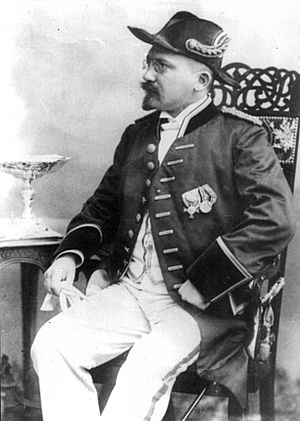Emil Krebs facts for kids
Quick facts for kids
Emil Krebs
|
|
|---|---|
 |
|
| Born | 15 November 1867 Freiburg in Schlesien
|
| Died | 31 March 1930 (aged 62) |
| Occupation | Sinologist |
Emil Krebs was an amazing German man who lived from 1867 to 1930. He was known as a hyperpolyglot, which means he could speak and write many, many languages. Emil Krebs mastered 69 languages and even studied 120 more! He was also a sinologist, someone who studies Chinese language and culture.
Contents
Emil Krebs's Life Story
Growing Up and Learning Languages
Emil Krebs was born on November 15, 1867, in Freiburg, Germany. His father was a carpenter. When Emil was young, his family moved to Esdorf. He went to primary school there.
Later, he attended secondary schools in Freiburg and Schweidnitz. At school, he learned Latin, French, Hebrew, and Classical Greek. But Emil didn't stop there! He also taught himself many other languages. These included Modern Greek, English, Italian, Spanish, Russian, Polish, Arabic, and Turkish. By the time he finished school, he already knew twelve languages!
After school, Emil first studied theology at the University of Breslau. Then, he decided to study law at the University of Berlin.
Focusing on Foreign Languages
At the University of Berlin, Emil found a new department called the Oriental seminar. He realized that learning foreign languages was his true passion. He decided to focus on Mandarin Chinese. Many people thought Chinese was the hardest language to learn.
Emil started Chinese classes in 1887. By 1890, he passed his Chinese interpreter's exam with "good" marks. In just two years, he learned Chinese so well that he sounded like a native speaker.
Even with his love for languages, he kept up with his law studies. He passed his first law exam in 1891. After that, he worked as a junior lawyer. Soon, he started learning Turkish at the university. In 1893, Emil Krebs was sent to Beijing, China, to work as an interpreter.
Working in China
Emil Krebs arrived in Beijing, China, in December 1893. He lived and worked there until World War I. He was a diplomatic translator for Germany in Beijing and Tsingtao. He took more Chinese exams and kept getting good marks. People were very impressed by how well he spoke Chinese.
In 1901, he became the Chief Interpreter. He even became a close friend of Empress Dowager Cixi. She was amazed by his elegant Chinese writing. She often invited him for tea to talk. While in China, Emil also learned Mongolian, Manchurian, and Tibetan. He even helped Chinese officials learn about other languages spoken in their country. He once translated a letter from Mongolian rebels for the Chinese government.
Emil loved learning languages more than anything. He would often stay up all night studying. He had a special way of learning: he would study a different language each day of the week. He had a huge library, organized by language. He would write summaries for each book and review them often. He only socialized if he could practice one of his languages.
He could learn languages incredibly fast. A German friend in China, Werner Otto von Hentig, told a story. He heard two people speaking a language he didn't know. He found out it was Armenian. Emil then learned Armenian in just nine weeks!
In 1913, Emil married Mande Heyne in Shanghai. In 1917, because of World War I, Emil Krebs returned to Germany.
Back in Berlin
Emil Krebs arrived back in Berlin in May 1917. He worked for the intelligence office, helping with coding. After World War I, he worked in translating and interpreting. During this time, he continued to dive deep into language study.
Emil Krebs passed away in March 1930, at his home in Berlin. He collapsed while working on a translation. He was buried in the Südwestkirchhof Stahnsdorf cemetery. After his death, his brain was studied by a researcher named Oskar Vogt. It is still kept as an "elite brain" at a university in Düsseldorf.
Krebs's Amazing Language Legacy
Emil Krebs left behind a huge private library. It has over 3,500 books and writings in about 120 languages! This collection is now kept at the Library of Congress in Washington, D.C..
From his books and his own language list, we know that Emil Krebs mastered many languages. These include all the languages of today's European Union. He also knew languages like Coptic, Ainu, Albanian, Arabic, Armenian, Burmese, Chinese, Georgian, Hebrew, Japanese, Javanese, Korean, Latin, Manchu, Mongolian, Nivkh, Persian, Russian, Sanskrit, Aramaic, Tibetan, Turkish, and Urdu.
Emil Krebs didn't just learn languages from his native German. He used languages he already knew to learn new ones. For example, he used English to learn Pashto, Burmese, Gujarati, Hindi, Irish, Sinhalese, and Portuguese. He used Russian to learn Buryat, Finnish, Tatar, and Ukrainian. And he used Spanish to learn different Basque dialects.
Besides German, he often used English, French, Russian, Chinese, Greek, Italian, Turkish, Latin, Spanish, and Arabic to help him learn and improve new languages. He even passed official government language tests in Chinese, Turkish, Japanese, and Finnish. To help him study, he used 61 different translations of the New Testament.
Works
Emil Krebs translated a book called Chinese Shade Plays by Wilhelm Grube. It was published in 1915.
See also
 In Spanish: Emil Krebs para niños
In Spanish: Emil Krebs para niños
- Sinology
- Giuseppe Mezzofanti
- Lorenzo Hervas y Panduro
- Johan Vandewalle
- List of polyglots

